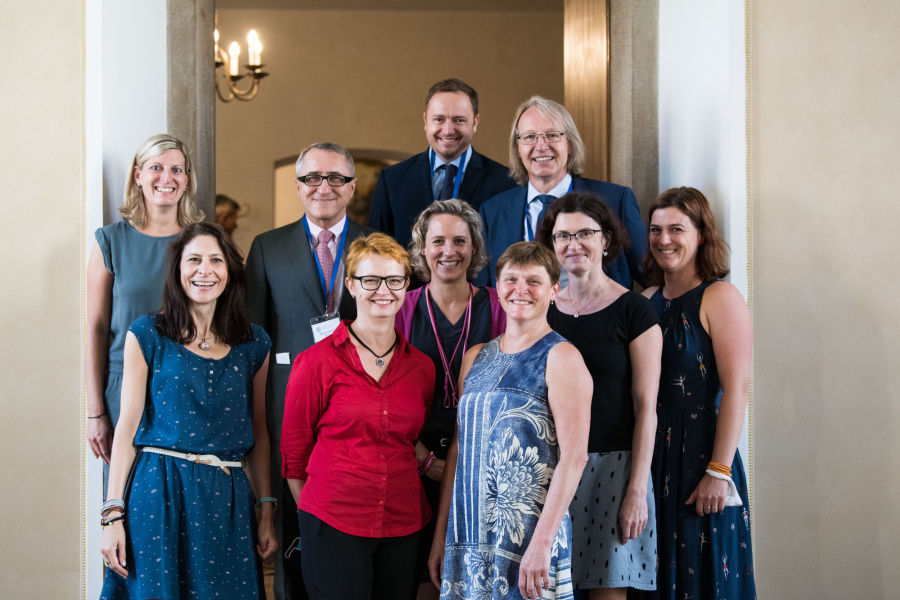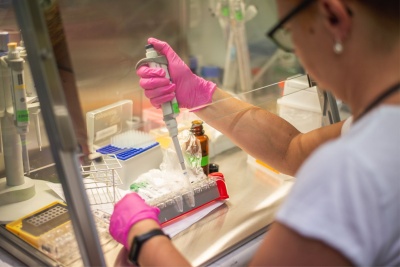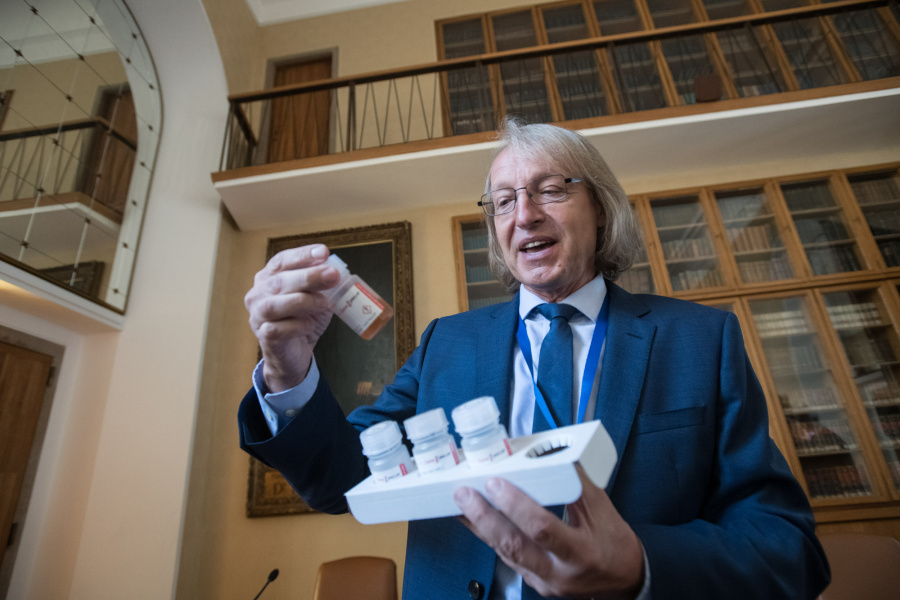Pavla Hubálková • foto: René Volfík, GeneSpector archive • 10 September 2020
Stanislav Kmoch on know-how that made testing for Covid safer
Lab contributed to testing and put years of experience into new commercial kit
For 30 years, Professor Stanislav Kmoch has devoted himself to the research of rare diseases; during the coronavirus pandemic, his laboratory was able to apply significant know-how in the development of new diagnostic kits for the detection of Covid-19 and other virus-related illnesses. While it was a side-project, the results speak for themselves: a commercially available product which should make the detection of Covid-19 faster and safer. Kmoch’s contribution led to the founding of the university spin-off GeneSpector, which introduced its product earlier this week.

Charles University's Stanislav Kmoch (back row, last on the right) together with colleagues. Kmoch's work and extensive focus on diagnostic methods led to new lab kits for testing for Covid-19.
How important was your experience with research into rare diseases when it came creating a new kit for the novel coronavirus?
Rare diseases are unusual in the sense that you have a limited number of patients, often living in isolated conditions in faraway places. Often samples that we study take a long time to reach us from halfway around the planet, so that means samples have to be properly treated to both survive the journey as well as to be safe as they could be potentially infectious. For that reason we developed a special system of sample collection and transport.
I understand that the specifics of the fluid called viRNAtrap used to preserve samples [and render them safe - Editor’s note] is a trade secret but is it something unique?
It is. Although it is created from various raw materials which are readily available, the precise recipe is the result of years of know-how and research. We’ve created many litres of it in our lab; we had an historic advantage as in the past we had to find many solutions ourselves while relying on standard approaches in molecular biology. We know exactly how each ingredient in the fluid works. It’s a sad state of affairs that a lot of labs get a commercial kit, where they have two fluids A and B and a set of exact instructions, meaning they don’t have to think about it further. But it also means not knowing what is going on chemically.
How did your lab get involved in testing for the coronavirus?
I was with my daughter Tereza [a student at CU and successful skier who was interviewed by Forum recently – editor’s note] at the World Cup in Sweden when the start of the pandemic caught up with us and they began closing the borders. It was difficult to get back to the Czech Republic and I spent 14 days self-isolating or in quarantine which was required. That was the period when all academics began testing. I got a call from my neighbour, colleague and friend Prof. Zdeněk Kleibl, asking of we might help with testing at the General University Hospital in Prague. It made sense to me: to help protect patients, medical personnel, and laboratory staff. All of them were suddenly in the middle of handling a large volume of potential highly infectious samples.

The preparation of samples for testing.
What are some of the specific ways you helped?
At the start of the crisis, there was a shortage of individual components needed for the diagnostic process: test tubes, swab sticks, kits for isolating RNA, chemicals for PCR analysis, disposable plastics. In the first phase, we provided the hospital with our fluid which neutralised infectious samples while preserving them. With the samples made safe, lab workers could work under normal conditions, which helped a lot.
The fluid is compatible with all kinds of swabs and useable with all types of isolated RNA. We expected that a lot of samples would have to be analysed so we lent colleagues our robot and an optimal method for isolating RNA with the help of magnetic bearings. We managed to speed up the test significantly – from a previous five hours to just one. About 10 people worked on this and I have to say the team is excellent, digging deep, looking for solutions, and if there was a way to come up with an improvement, members did. So in a short period of time, we were able to offer improved testing.

Professor Kmoch with the new kit, presented at Charles University in September 2020.
How was GeneSpector founded?
It was a lucky coincidence: I was in quarantine and I was working on an article which had also been worked on by PhD. student Michal Pohludka (who is now GeneSpector’s executive head) and I mentioned we were testing coronavirus samples. He was focused on the same problem at the time. So I wrote him explaining how we did it and could offer a new faster and safer approach and he was intrigued. I lent him samples he could test and that was how things started and how GeneSpector got off the ground.
What has all this meant for you?
For me it’s a side project but one with a very satisfying and pleasant result, made possible by years of research into rare diseases. I am very happy that our method makes it safer for lab technicians and that we simplified and sped up the diagnostic process. The commercialisation of the product, however, I leave to others. At the same time, the results and the samples collected opened the door for new research. You can re-test samples but study other aspects: when you take a swab you don’t capture just coronavirus but also bacteria or hosts’ RNA.
So more possibilities…
If you have a positive sample you can study other pathogens which could help explain why some patients have no signs of infection and others suffer a much heavier illness. If you take something like the Spanish flu, the illness itself was not responsible for most deaths but the bacteria Streptococcus pneumoniae combined with malnourishment. You can examine certain molecular markers which can potentially reveal why one person in a household is infected and another is not. I could go on and on. I’m a little bit sorry there aren’t more studies of that kind, as we have a lot of positive samples now and clinical data for this kind of research. I think that we could learn a lot more about the course of this disease.
|
Professor Stanislav Kmoch |
|
Based at the Department of Pediatrics and Adolescent Medicine at the First Faculty of Medicine at Charles University and the General University Hospital. Heads the National Center for Medical Genomics as well as research of diagnostic and medical treatment methods at the BIOCEV biomedical facility in Prague. Has focused extensively over the course of his career on creating new diagnostic methods, many of which were implemented into practice. |
Translated by Jan Velinger
You can read the original interview in Czech here.
